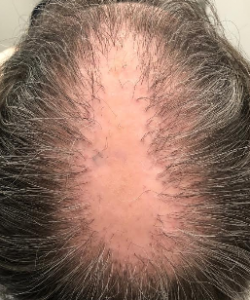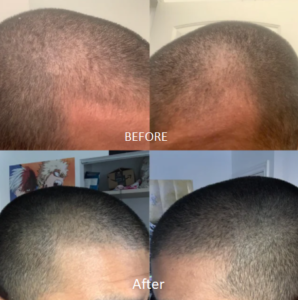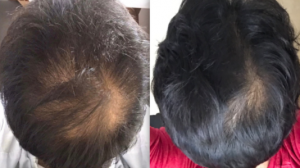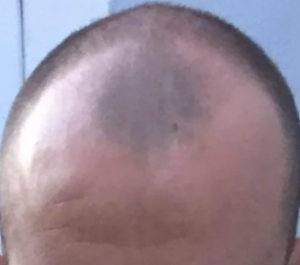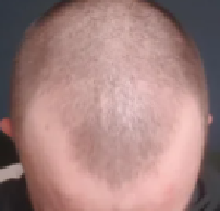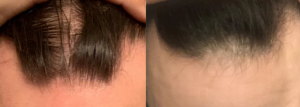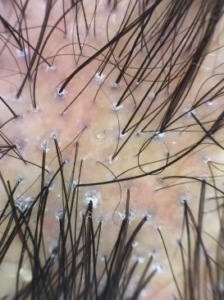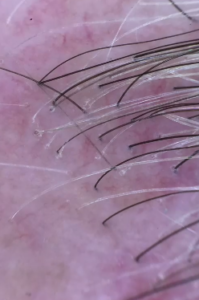This patient should not have a hair transplant as his disease, LPP, will kill any transplanted hairs. The previous hairs were replaced by scar tissue. This disease is evident by the shinny, scar ridden skin, the lack of vellus hairs around the hairy edge as it transitions into normal scalp. This disease is thought to be present more than most doctors realize and could be found in men in their late 20s or 30s. We have thought that women were more susceptible to having this disease in the past.
I had a horrible experience with biofiber hair transplants since 2 years and since that say I didn’t have one day without pimples and small abscess , I had traveled 2 times and lost too much money with no benefits. I searched everywhere to find someone Can remove it and even the part inside the scalp. It was a big mistake that I totally regret it, Please assess my condition if there’s any hope.
An experienced doctor may be able to remove each of the fibers as they are either (1) identified on the scalp with an FUE punch, (2) become infected. The general problem is that many times, buried biofibers remain even after individual surgical attempts to find them all is completed. You have to have a good relationship with the doctor who is removing them and realize that this problem may go on for a long time if any of the fibers are not found at the initial time the surgeon attempts to remove them.
This procedure, the use of artificial hair fibers implanted into the scalp, has been banned by most countries. Any doctor trying to do this in the United States could expect to be in trouble with their medical license. I know how good they look for the first few weeks as I have met a few patients that had them many years ago, but then hell pays a visit. You have been there, it seems, and you are still there until these fibers eventually work their way out. The good news is that they will eventually be pushed out by your body but multiple infectious periods may have to be managed, experience after experience by an easily accessible doctor.
I have an abundance of neck hair, hair that almost goes to the top of my back. I’m used to shaving that part of my neck (genetic I guess as it’s something some of my family has) Could this be used as possible donor hair for FUE if you have long hair and aren’t comfortable with shaving a typical donor area location?
Neck hair is not permanent hair in many man. Worse still, is that incisions of any sort that are made in the back of the neck has an increased risk of scarring and scar stretching. Some people taking finasteride find that their neck hair disappears (not always).
I had my HT in September, I never took minoxidil because even though I heard it will make my hair grow back faster I do not have the necessary time to use it twice a day, so I only use finasteride. Today marks the 3 month since the HT, and it just seems like my hair doesn’t want to fall off now,I never thought that I could be mad that my hair doesn’t want to fall off but here I am. Some people shed in the first month and by the third they already start noticing minor gains, while mine hasn’t even fully fallen yet.
Immediate growth occur in some of the hairs in a hair transplant 95% of people lose the hair as it goes through a rest phase after the transplant and then grows out 2-4 months later. In about 5% of my patients, there is instant growth and the hair never goes through the rest phase.
Asians, on average, have about 85,000 birth hairs on their head, so 25% of that can be moved for hair transplants in your lifetime, assuming you are mid-point on the bell curve for Asian hair numbers. Assuming that you have an average hair weight (not fine), then there should be 5000 grafts available during your lifetime. If your hair is coarse, then the numbers swing in your favor regardless of your total hair count. I have written articles on the use of SMP to extend the reach of a hair transplant for a fuller cover.
A recent study suggests that most women actually LOVE bald men. And that hairy men easily get jealous of bald people Also genetic analysis has found out that balding men have the best genes for strong bodies
Bald is better?
Shaving your head may give women a sense that you have self-confidence and women love men who are confident in themselves.
If you disease is under control and you understand the risks associated with having a hair transplant, then the answer is yes. There could be an increased risk of hair rejection if the autoimmune disease impacts the skin which can happen anytime after the surgery, even years out
“Generally speaking, a person has three stages of hair growth cycle: growth, degeneration and rest. In the first stage, the hair is a continuously pushed-out shaft, whereas the hair stops growing and its lower portion shrinks while staying in place in the second stage. In the third stage, however, the hair eventually falls out.
While it has been known for some time that stress is linked to hair prematurely entering the third stage and falling out, as is the overall link between hair loss and chronic stress itself, the exact mechanism behind this link had remained a mystery.
What is known is that hair-follicle stem cells (HFSCs) play an essential role in hair growth by interpreting internal and external signals. Knowing this, Cho and the other researchers tested the role another area of the body – the stress-hormone producing adrenal gland – played in the cycle. To do this, they removed them from mice via surgery.
Without the adrenal glands to produce stress hormones, the mice’s “rest” phase in their hair cycles was much shorter, while their hair follicles grew around three times more than normal. But when fed the hormone corticosterone, the stress hormone produced by animal adrenal glands, their hair growth was suppressed.
So does corticosterone play a role in making hair fall out? That’s what this implies. HFSCs detect the stress hormone through signals, and not by detecting the hormone itself. This was determined when the researchers selectively deleted the protein known as glucocorticoid receptors in the dermal papillae. These receptors are the means by which the hormone signals the HFSCs.”
I remember you saying that younger men tend to respond to finasteride well. Is that true? If so, how?
Yes, that is true: When hair is recently lost, reducing the impact of DHT which suppress hair growth can be block by this drug in younger men. The longer the hairs are either miniaturized or have disappeared from your scalp, the harder it is to bring it back.
Trichoscopy, the examination of the scalp with magnification for diagnosis, is critical to be able to detect the presence of diseases that might be a contra-indication to hair transplantation. A hair transplant done on a person with FFA or LLP will fail. A biopsy of the scalp confirms the diagnosis.
The first picture on the left, shows a patient with genetic hair loss and a disease called Lichan Pilnopilaris (LLP). If this patient is not examined with a Trichoscope to make this diagnosis and had a hair transplant, it would fail. Note the crusting around each of the terminal hairs that are typical of LLP. This is an autoimmune disease of the scalp.
The picture on the right shows a man who is 33 years old, and had corner recession typical of a genetic Norwood Class 3 pattern of balding, but Trichoscopic examination showed Frontal Fibrosing Alopecia (FFA) which is highly unusual in a 33 year old male but if he had a hair transplant, it would fail as the former patient with LLP. The picture shows the absence of vellus hairs which is typical of FFA. This is an autoimmune disease of the scalp that killed off all of the vellus hairs.
Page 159 of 1247



